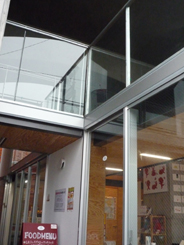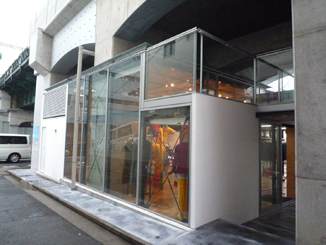 |
|
 |
Kogane Studio's inviting back side
|
|
Inside the sky-lit Kogane Studio |
|
What was once the red light district of Yokohama is now undergoing a makeover. The Koganecho Bazaar, occurring in tandem with the Yokohama Triennale, promises to be the first step towards regenerating this dilapidated district. Local and foreign artists are showing in two new artist studio buildings, the main venues for the event. The semi-permanent Kogane and Hinode Studios were commissioned as infill projects located under the Keihin Electric elevated railway that runs along the Ooka River.
There is a long list of precedents for building on or under bridges, and this way of interweaving two types of program together has always been an interest of mine. Ponte Vecchio in Florence and the Rialto Bridge in Venice are historical examples. A more current implementation is the upscale Food Emporium, Conran Shop and Guastavino's restaurant by Sir Terence Conran located under the Queensboro Bridge in New York. Throughout Japan I have enjoyed seeing the ingenious ways in which such leftover spaces are maximized.
Just a few meters from Koganecho station is the corrugated metal-clad Kogane Studio, designed by Masashi Sogabe with students from the Sogabe Laboratory at Kanagawa University. The timber-framed atelier building is nestled under the elevated tracks. The width of a structural bay delineates each artist studio and central café space. The building has a lovely shed roof in section with skylights over the lower portion. It has two distinct facades: the higher "river side" with pop-out windows to display each of the artists' work, and the lower "shitamachi side" which is almost entirely wood-framed sliding doors.
The cross-section would have been more effective had it been oriented with the inviting lower side toward the river, from where most visitors naturally approach. The artists who occupy Kogane Studio may have preferred a view out toward the river through their large sliding glass doors rather than their display pop-out windows as well. The choice of corrugated metal would be original if applied where it wasn't expected, say in a residential neighborhood, but in this context, it's a usual suspect. The color does not distinguish itself well from the color of the bridge.
The simple, long interior space is welcoming and interactive. Workspaces are meant for very clean work such as small paper and handicrafts. When I visited, no one that I saw was painting, sculpting or doing any work that requires a mask.
Further down the Ooka River toward Hinodecho Station is Hinode Studio, designed by Yoshihiko Iida and students from Yokohama National University. Its use as mainly gallery and fashion-focused retail spaces is appropriate due to the favorable street presence at the corner of Asahibashi and the river walk. This creative prototype for a "three-block studio" employs structural steel and wood with tall showroom windows. The outdoor spaces between each volume are usable and interactive as these are provided cover by the tracks above. The form is surprisingly simple and determined by the height restriction under the tracks. A two-meter high outdoor-accessible promenade level links and allows visual access into the spaces below. This feature made me wonder how to prevent the public from "hanging out" there after hours.
Inside the finishes are appropriately crude, mainly exposed plywood. The shops and works on display seemed more ephemeral than the structure itself. In fact, the staff in the "Tamiya Taro & me Issey Miyake" exhibit couldn't tell me how long they would be there.
These two new studio projects not only occupy space below the tracks, they both celebrate it. Kogane Studio has its skylights and Hinode Studio its promenade that gets the visitor close enough to touch the concrete structure overhead. The Koganecho Bazaar, however, does not acknowledge or even reference the controversial nature of its environs. The promotional material in English describes Koganecho as Yokohama's former red light district. It doesn't seem to be former but rather just a stagnant, not-so-busy red light district. These types of pocket art venues are wonderful amenities for the community but it is a lot to expect for them to revitalize an entire district.
 |
|
 |
| A detail of Hinode Studio |
|
A view into the "Tamiya Taro & me Issey Miyake" Exhibit |
|
|